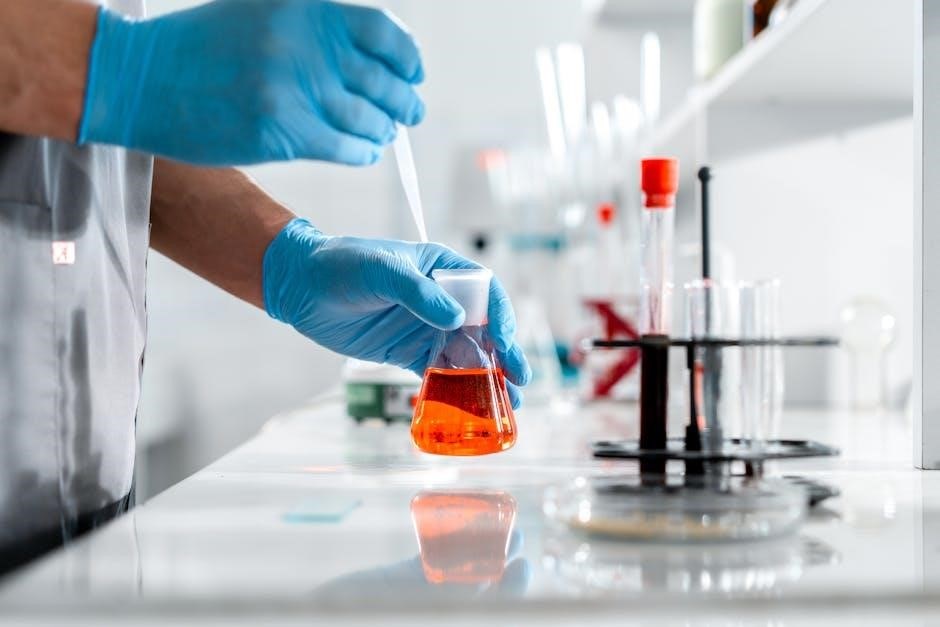This manual provides a comprehensive guide for general chemistry lab work, offering hands-on experience with essential techniques, safety protocols, and experiments to reinforce theoretical concepts and practical applications.
1.1 Overview of the Manual
This manual is designed to provide a structured and comprehensive approach to general chemistry laboratory work. It includes detailed procedures for 14 experiments, covering fundamental concepts such as measurement techniques, titrations, and chromatography. The manual emphasizes safety protocols, proper laboratory etiquette, and the importance of accurate record-keeping. Each experiment is accompanied by pre-lab questions to prepare students and post-lab analyses to reinforce learning. Topics range from basic skills like density calculations to advanced procedures such as spectrophotometry and vacuum filtration. The manual also features a capstone project where students apply their knowledge to separate and identify metal ions in water samples, promoting critical thinking and practical application of chemical principles.
1.2 Importance of Lab Work in Chemistry Education
Lab work is a cornerstone of chemistry education, bridging theoretical concepts with practical application. It provides students with hands-on experience, fostering critical thinking, problem-solving, and analytical skills. Through experiments, students gain a deeper understanding of chemical principles, such as stoichiometry, titrations, and thermodynamics. Labs also cultivate essential skills in data collection, measurement accuracy, and error analysis. By engaging in real-world applications, students connect chemistry to everyday life, enhancing their appreciation for scientific inquiry. Lab experiences prepare students for future careers in STEM fields by developing their ability to design experiments, interpret results, and communicate findings effectively. This practical training is indispensable for building a strong foundation in chemistry.
1.3 Safety Guidelines and Laboratory Etiquette
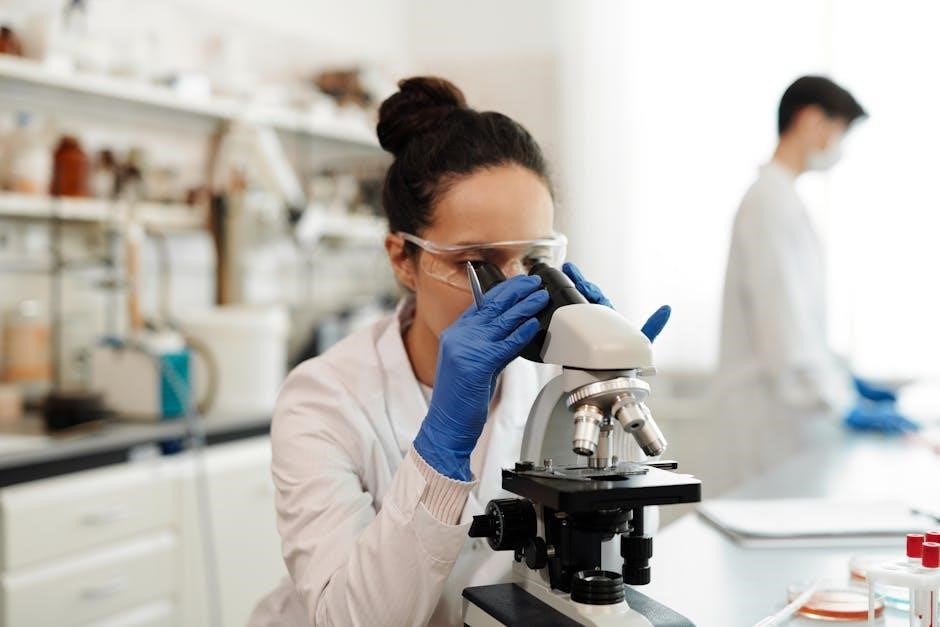
Safety is paramount in the chemistry laboratory. Students must adhere to strict guidelines to minimize risks. Essential precautions include wearing personal protective equipment (PPE) such as goggles, gloves, and lab coats. Chemicals should be handled with care, and their labels read thoroughly. Open flames, electrical equipment, and sharp objects require special attention. Food and drink are prohibited in the lab. Spills or accidents must be reported immediately, and proper cleanup procedures followed. Students should avoid horseplay and distractions, ensuring a focused environment. Lab etiquette also includes respecting shared equipment, cleaning up after experiments, and disposing of waste correctly. Failure to follow safety protocols can lead to injuries or disciplinary action. A safe and respectful lab environment ensures successful learning and experimentation.
Essential Laboratory Techniques
This section introduces foundational lab skills, including measurement, titration, filtration, and reflux. These techniques are crucial for conducting experiments accurately and safely, building a strong experimental foundation.
2.1 Measurement of Mass and Volume
Accurate measurement of mass and volume is fundamental in chemistry. Mass is typically measured using a balance, while volume is measured with graduated cylinders or pipettes. These techniques ensure precision in experiments, such as titrations and density calculations. Proper use of laboratory tools is emphasized to minimize errors. Understanding units like grams and milliliters is essential for accurate data collection. This section provides detailed procedures for measuring mass and volume, highlighting their importance in stoichiometric calculations and experimental results. Mastery of these skills is critical for success in general chemistry lab work, as they form the basis for more complex procedures.
2.2 Titration Procedures
Titrations are fundamental in chemistry for determining the concentration of unknown solutions. This procedure involves the controlled addition of a standard solution (titrant) to another solution (analyte) until a reaction endpoint is reached. Acid-base titrations are common, using indicators to signal the equivalence point. Proper use of burettes and pipettes is essential for accuracy. The Henderson-Hasselbalch equation is often applied to relate pH, pKa, and the ratio of conjugate base to acid. Titration skills are crucial for experiments like determining ΔH and ΔS for solubility equilibria. This section provides step-by-step guidance on titration techniques, emphasizing precision and safety to ensure reliable results in various chemical analyses.
2.3 Filtration and Reflux Techniques
Filtration is a critical laboratory technique used to separate solids from liquids. Gravity filtration is commonly employed for routine separations, while vacuum filtration accelerates the process using suction, ideal for finer particles. Reflux techniques involve heating a reaction mixture while condensing and returning the solvent, preventing its loss and ensuring reaction completion. Both methods are essential for maintaining purity and yield in chemical experiments. Proper use of equipment, such as filter paper and condensers, is emphasized to avoid contamination and ensure safety. These techniques are widely applied in experiments like solvent evaporation and separation processes, reinforcing practical skills in chemistry labs.
Common Laboratory Experiments
Experiments include determining density, melting points, chromatography, and formula of hydrated salts. These activities connect chemistry to real-life scenarios, enhancing understanding and practical skills for students.

3.1 Determination of Density
The determination of density is a fundamental experiment in general chemistry, introducing students to the relationship between mass and volume. By measuring the mass of a substance using a digital balance and its volume with a graduated cylinder or pipette, students calculate density using the formula: density = mass/volume. This experiment enhances understanding of physical properties and their significance in identifying substances. It also emphasizes the importance of precise measurements and data analysis. The activity aligns with real-world applications, such as quality control in industries, where density measurements are crucial for material characterization. This hands-on approach reinforces theoretical concepts and develops practical laboratory skills essential for chemistry students.
3.2 Melting and Boiling Points of Substances
Determining the melting and boiling points of substances is a key experiment in general chemistry, allowing students to explore the physical properties of matter. By heating substances and observing phase changes, students learn to identify and characterize compounds. This experiment emphasizes the importance of accurate temperature measurements and the use of laboratory equipment such as melting point apparatuses. The activity also introduces students to the concept of intermolecular forces and their role in determining these thermal properties. Practical applications of this experiment include material identification and purity testing, making it a valuable skill in fields like materials science and pharmaceutical chemistry. The experiment reinforces the connection between theoretical concepts and laboratory observations.
3.3 Chromatography and Its Applications
Chromatography is a fundamental laboratory technique used to separate, identify, and quantify the components of a mixture. In this experiment, students learn to apply chromatography to analyze substances, such as food dyes or plant pigments. The process involves spotting samples on a chromatogram, developing it in a solvent, and observing the separation of compounds based on their interactions with the stationary and mobile phases. This experiment introduces students to the principles of separation and the factors influencing chromatographic results. Practical applications of chromatography are highlighted, including drug testing, environmental monitoring, and food analysis. By performing this experiment, students gain hands-on experience with a widely used analytical technique and develop their understanding of chemical separation methods. This skill is essential for advanced studies in chemistry and related fields.
3.4 Formula of a Hydrated Salt
Determining the formula of a hydrated salt is a classic experiment that combines stoichiometry and laboratory techniques. Students learn to heat a hydrated salt to remove water of crystallization, then calculate the empirical formula based on mass measurements. This experiment reinforces concepts of molar relationships, mass conservation, and chemical composition. By analyzing data, students determine the number of water molecules bound to the salt. The process involves precise measurements, careful heating, and data analysis. This hands-on activity connects theoretical chemistry to practical lab work, helping students understand how chemical formulas are experimentally derived. It also emphasizes the importance of accuracy in measurements and the application of stoichiometric principles in real-world scenarios.
3.5 Electrical Conductivity of Aqueous Solutions
This experiment introduces students to the concept of electrical conductivity in aqueous solutions, exploring how different substances conduct electricity. By testing various solutions, including strong acids, bases, and weak electrolytes, students observe how ion concentration and type affect conductivity. Using a conductivity probe or similar device, they measure and compare the electrical conductivity of different solutions. This activity reinforces the understanding of ionization, solubility, and the behavior of electrolytes in solution. Students analyze the data to draw conclusions about the relationship between chemical composition and conductivity. This practical exercise bridges theoretical concepts with real-world applications, helping students appreciate the role of conductivity in chemistry and engineering. The experiment emphasizes the importance of accurate measurements and data interpretation in understanding solution behavior.

Data Analysis and Interpretation
Data analysis and interpretation are crucial in chemistry, focusing on accuracy, precision, and error analysis. These elements help compare experimental results with theoretical predictions, ensuring experiment validity.
4.1 Accuracy and Precision in Measurements
Accuracy and precision are fundamental in chemistry, ensuring reliable data. Accuracy refers to how close measurements are to the true value, while precision measures consistency. Proper calibration of instruments and careful techniques enhance accuracy. Repeated measurements improve precision, reducing errors. Understanding these concepts is vital for valid experimental results and comparisons with theoretical data.
4.2 Error Analysis and Its Significance
Error analysis is crucial in chemistry for understanding the reliability of experimental data. It involves identifying and quantifying sources of error, such as instrument calibration issues or human factors. Systematic errors, like faulty equipment, affect all measurements consistently, while random errors vary. Minimizing these requires careful techniques and repeated trials. Error analysis also helps distinguish between precision and accuracy, ensuring results align with theoretical expectations. By evaluating errors, students can refine their methods, improving the validity and reproducibility of their work. This process fosters critical thinking and attention to detail, essential skills in scientific inquiry and data interpretation.
4.3 Comparing Experimental and Theoretical Results
Comparing experimental and theoretical results is a cornerstone of scientific inquiry, allowing students to validate their findings and understand the principles underlying chemical processes. This comparison helps identify discrepancies, which can stem from experimental errors or limitations in theoretical models. By analyzing these differences, students gain insights into the accuracy of their methods and the reliability of their data. Such comparisons also reinforce conceptual understanding, as they highlight how real-world outcomes align with or deviate from expected results. This process encourages critical thinking and problem-solving, essential for refining experimental techniques and interpreting data effectively in a general chemistry laboratory setting.

Specialized Laboratory Procedures
This section covers advanced techniques like vacuum filtration, solvent evaporation, and spectrophotometry, essential for refining substances and analyzing chemical properties in a general chemistry laboratory setting.
5.1 Spectrophotometry and Its Applications
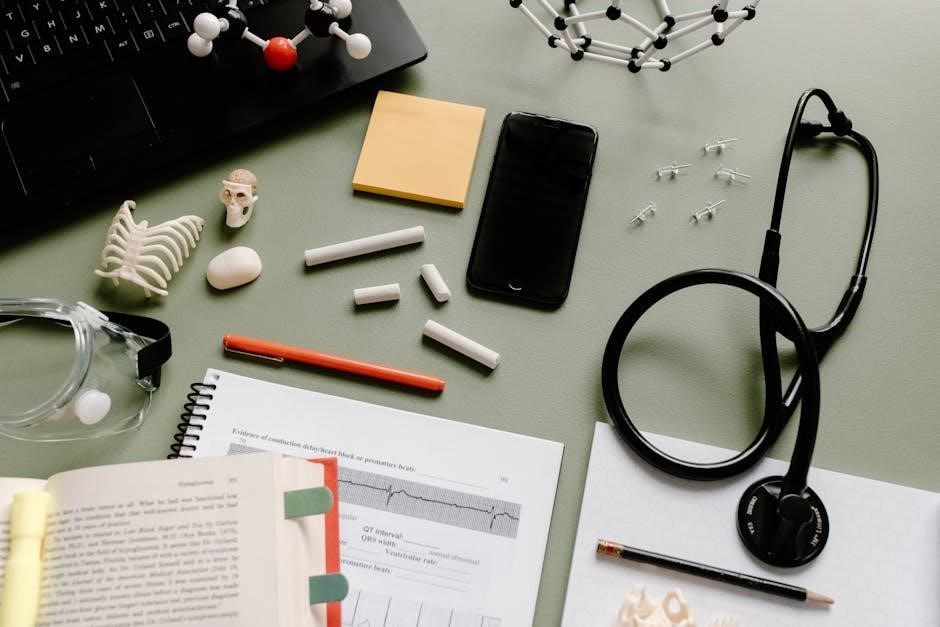
Spectrophotometry is a powerful analytical technique used to measure the interaction between light and matter, providing insights into chemical composition and concentration. In a general chemistry laboratory, this method is widely applied to determine the concentration of solutions, study chemical reactions, and analyze the properties of substances. Students learn to operate spectrophotometers, prepare samples, and interpret absorbance data. The technique is essential for understanding Beer-Lambert Law principles and their practical applications. Common experiments include enzyme kinetics, protein quantification, and the analysis of colored solutions. This section of the manual guides students through hands-on experiments, emphasizing safety, precision, and data interpretation, making it a cornerstone of advanced laboratory training in chemistry.
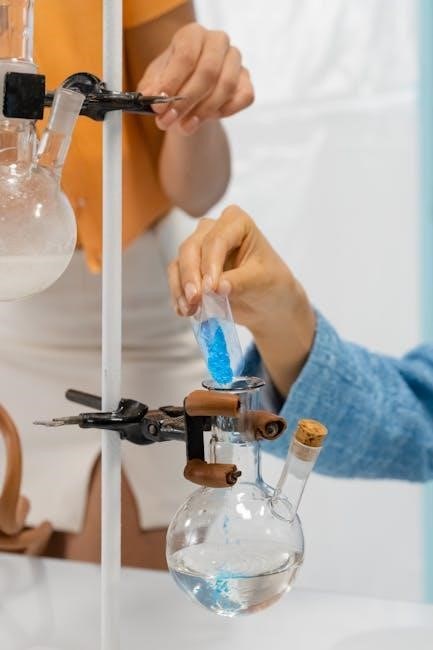
5.2 Vacuum Filtration and Solvent Evaporation
Vacuum filtration and solvent evaporation are essential techniques in a general chemistry laboratory for isolating solids and removing solvents. Vacuum filtration uses reduced pressure to accelerate the separation of solids from liquids, ensuring efficient collection of precipitates. Solvent evaporation involves heating solutions under controlled conditions to remove volatile solvents, often used in purification processes like recrystallization. These methods are critical in experiments requiring pure samples, such as determining melting points or analyzing compounds. Proper maintenance of vacuum equipment and careful handling of heated solutions are emphasized to ensure safety and accurate results. These procedures are integral to advanced laboratory workflows, enabling students to master separation and purification techniques fundamental to chemical analysis.
Advanced Topics in General Chemistry
This section explores complex concepts like stoichiometry, acid-base chemistry, and gas laws, providing deeper insights into chemical reactions and their practical applications in laboratory settings.
6.1 Stoichiometry and Chemical Reactions
Stoichiometry is a fundamental concept in chemistry, focusing on the quantitative relationships between reactants and products in chemical reactions. This section explores the application of stoichiometric principles to predict reaction outcomes, calculate yields, and balance chemical equations. Students learn to determine limiting reagents, theoretical yields, and percent efficiency in experiments. Practical exercises include titration experiments, where stoichiometry is used to calculate concentrations of acids and bases. The section also delves into the relationship between stoichiometry and thermodynamics, enabling students to analyze reaction spontaneity and equilibrium. By mastering these concepts, students gain a deeper understanding of how chemical reactions proceed and how to apply mathematical tools to solve real-world problems in chemistry.
6.2 Acid-Base Chemistry and Buffer Solutions
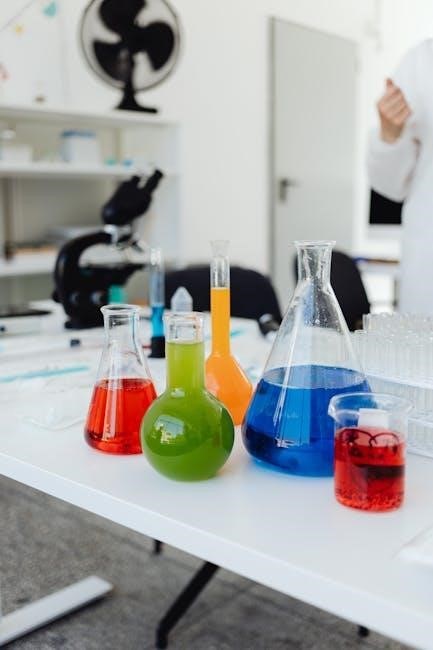
Acid-base chemistry is a cornerstone of general chemistry, focusing on the behavior of acids and bases in aqueous solutions. This section explores the principles of acid dissociation, pH calculation, and the Henderson-Hasselbalch equation. Students learn to analyze buffer systems, which resist pH changes upon addition of small amounts of acid or base. Practical exercises include titration experiments to determine the concentration of unknown acids or bases and the design of buffer solutions for specific applications. The section emphasizes the importance of buffers in real-world scenarios, such as biological systems and industrial processes. By mastering acid-base chemistry, students gain essential skills in solution preparation and pH control, crucial for advanced laboratory work and theoretical understanding.

6.3 Gas Laws and Their Applications
This section delves into the fundamental principles of gas behavior, including Boyle’s, Charles’s, and Avogadro’s laws, culminating in the ideal gas law. Students explore how these laws interrelate pressure, volume, temperature, and moles of gas. Practical experiments involve determining the molar mass of a gas and analyzing the ideal gas law using experimental data. Applications of gas laws are highlighted in stoichiometry, respiratory physiology, and industrial processes. The section emphasizes the importance of understanding gas behavior in real-world scenarios, such as scuba diving and atmospheric science. Through hands-on activities, students develop problem-solving skills and a deeper appreciation for the role of gases in chemical systems and everyday life.
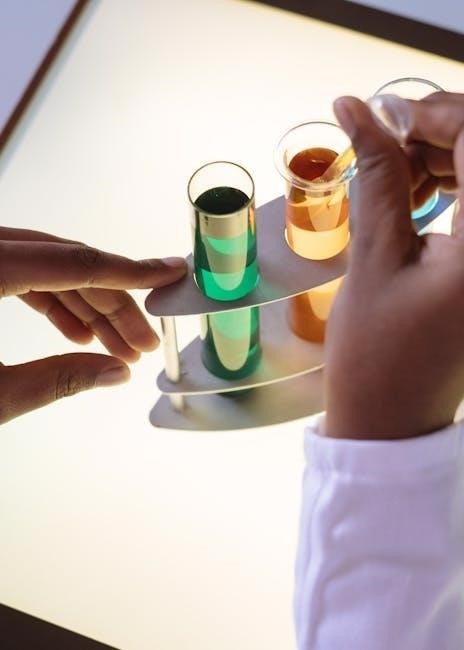
Capstone Laboratory Project
The capstone project challenges students to design and execute procedures for separating and identifying metal ions in water samples, fostering independent problem-solving and analytical skills.
7.1 Separation and Identification of Metal Ions in Water Samples
This capstone project challenges students to design and execute procedures for separating and identifying metal ions in water samples. It integrates concepts such as filtration, titration, and chromatography to isolate and analyze metal ions. Students apply techniques like precipitation, complexation, and spectroscopy to identify the ions. The project emphasizes independent problem-solving, data interpretation, and laboratory safety. By completing this, students gain hands-on experience in environmental chemistry and analytical methods, preparing them for real-world applications in water quality analysis and geochemistry.
